高中英语词汇教学案例
- 格式:docx
- 大小:14.31 KB
- 文档页数:2
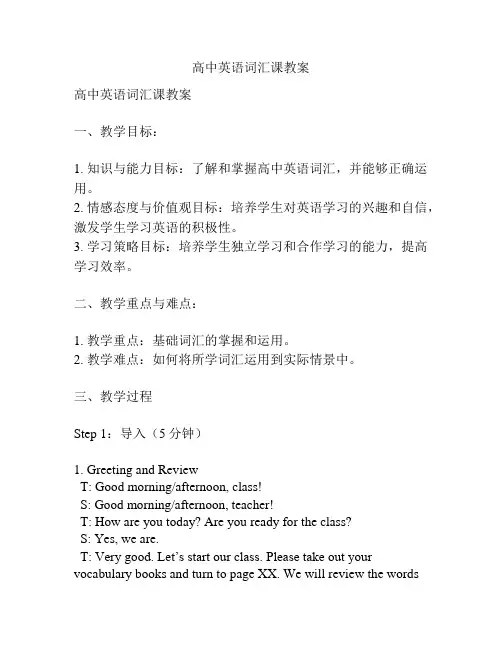
高中英语词汇课教案高中英语词汇课教案一、教学目标:1. 知识与能力目标:了解和掌握高中英语词汇,并能够正确运用。
2. 情感态度与价值观目标:培养学生对英语学习的兴趣和自信,激发学生学习英语的积极性。
3. 学习策略目标:培养学生独立学习和合作学习的能力,提高学习效率。
二、教学重点与难点:1. 教学重点:基础词汇的掌握和运用。
2. 教学难点:如何将所学词汇运用到实际情景中。
三、教学过程Step 1:导入(5分钟)1. Greeting and ReviewT: Good morning/afternoon, class!S: Good morning/afternoon, teacher!T: How are you today? Are you ready for the class?S: Yes, we are.T: Very good. Let’s start our class. Please take out your vocabulary books and turn to page XX. We will review the wordswe learned last time. Please read them out aloud one by one.2. Review the vocabularyT: Great job! Now let’s review the words together. (Teacher and students read the words together.)Step 2:新词学习与运用(20分钟)1. Introduce new wordsT: Now l et’s move on to our new words today. The first word is “advantage” which means a beneficial or helpful factor or circumstance.(Teacher writes the word on the blackboard or shows the flashcard.)Now let’s repeat after me. “advantage”.S: “advantage”.T: Very good. The second word is “disadvantage” which means an unfavorable or harmful factor or circumstance.(Teacher writes the word on the blackboard or shows the flashcard.)Now let’s repeat after me. “disadvantage”.S: “disadvantage”.2. Vocabulary practiceT: Now let’s practice the new words. I will give you some sentences. Please fill in the blanks with the correct forms of the new words.(Teacher writes the sentences on the blackboard.)Example: She took advantage of the opportunity to study abroad.1. One of the disadvantages of living in a big city is the highcost of living.2. The team has a clear advantage over their rivals.3. He used his knowledge to his disadvantage.(Students work in pairs or groups to complete the sentences.) Step 3:巩固和拓展(15分钟)1. Vocabulary quizT: Now let’s have a vocabulary quiz. I will give you a word and you need to tell me the meaning of it.(Teacher calls on individual students to answer the questions.) 2. Vocabulary gameT: It’s time for a vocabulary game. I will divide the class into two teams. Each team will take turns to give a sentence using the new words we learned today. The sentence should be related to a specific topic. The team that can give the most sentences wins.(Teacher divides the class into two teams and sets a topic for the game.)Example: Topic: SportsTeam A: She took advantage of the good weather to go for a run. Team B: One of the disadvantages of playing basketball is the risk of injury.(Teams take turns to give sentences until one team cannot come up with a sentence.)Step 4:小结与作业布置(10分钟)1. SummaryT: It’s time to summarize what we have learned today. Welearned two new words today: “advantage” and “disadvantage”. Can you give me the definitions of them?S: “advantage” means a beneficial or helpful factor or circumstance, and “disadvantage” means an unfavorable or harmful factor or circumstance.T: Very good. Now let’s review the sentences we practiced toda y. Can you give me some examples?S: (Students give examples of sentences using the new words.) 2. HomeworkT: Your homework for today is to write a short paragraph about the advantages and disadvantages of living in a big city. You can use the vocabulary we learned in class today. The paragraph should have at least 5 sentences.(Teacher writes the homework assignment on the blackboard.) Step 5:教学反思(5分钟)本节课主要是进行词汇学习和运用。
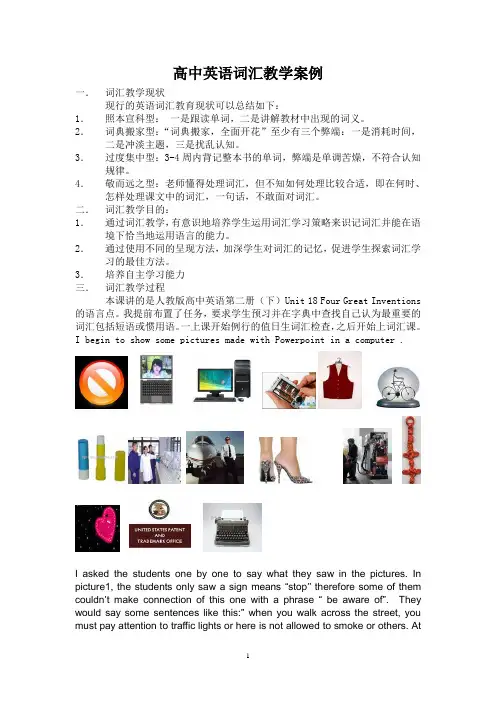
高中英语词汇教学案例一.词汇教学现状现行的英语词汇教育现状可以总结如下:1.照本宣科型:一是跟读单词,二是讲解教材中出现的词义。
2.词典搬家型:“词典搬家,全面开花”至少有三个弊端:一是消耗时间,二是冲淡主题,三是扰乱认知。
3.过度集中型:3-4周内背记整本书的单词,弊端是单调苦燥,不符合认知规律。
4.敬而远之型:老师懂得处理词汇,但不知如何处理比较合适,即在何时、怎样处理课文中的词汇,一句话,不敢面对词汇。
二.词汇教学目的:1.通过词汇教学,有意识地培养学生运用词汇学习策略来识记词汇并能在语境下恰当地运用语言的能力。
2.通过使用不同的呈现方法,加深学生对词汇的记忆,促进学生探索词汇学习的最佳方法。
3.培养自主学习能力三.词汇教学过程本课讲的是人教版高中英语第二册(下)Unit 18 Four Great Inventions 的语言点。
我提前布置了任务,要求学生预习并在字典中查找自己认为最重要的词汇包括短语或惯用语。
一上课开始例行的值日生词汇检查,之后开始上词汇课。
I begin to show some pictures made with Powerpoint in a computer .I asked the students one by one to say what they saw in the pictures. In picture1, the students only saw a sign means “stop‟‟ therefore some of them couldn‟t make connection of this one with a phrase “be aware of”. They would say some sentences like this:” when you walk across the street, you must pay attention to traffic lights or here is not allowed to smoke or others. Atthis time I began to ask the students what the sign said and when we saw this sign , what should be aware of. Following that , all the students said that they would be aware of safety. Then I asked my students to make sentences with the phrase be aware of as much as possible. Picture 2,3,4,5,6,7 are very easy . When they saw them , they would quickly remember what words they were. Once for a while I interestingly asked them what made the size of a computer reduced from desktops to laptops to palmtops and If they pretended to be specialists of a computer whether they allow for their creativity. After that the students discussed for a while ,then one reported the result. Picture8 tends to make the students remind the word “experiment” or ” laboratory” instead of “trial but they knew trial and error could lead to success and the truth of success is trial and error. Picture9 is about a “pilot “and picture10 is “heel”while picture11 ,12 and 13 need hard guess. Because in these pictures they couldn‟t see “ petrol ““ connection” and “ background”, teacher must lead in. For example I asked my students the following questions : What does picture 11 describe? Is it a gas station? What does the driver do ? What do Americans say “汽油”?When you see picture 12, what do you feel ? what association do you make? ( we often connect this China knot with good luck ) and in picture13, can you see the black color? What function is it used as? In this way, the students had a quick overview of some important new words in Unit 18. Secondly, I quickly show these pictures to the students. Then let them repeat these new words. In class I found it interesting for students to learn new words and with this method students‟motivation can be aroused. What‟s more ,it‟s easy for them to remember new words. When I finished this task , I began to check the students‟ preparations.In latter half class, the students play leading roles in class. They voluntarily come to the blackboard to teach the others the key words and phrases that they think are very important in Unit 18 . Although it is impossible for them to find the key points accurately , in practice they know how to learn new vocabulary. What …s more, the students are very active in involving in class.四.课后反思反思1:学生学习的主动积极性是学生学习的动力源泉而学习需要是学生长期坚持的内驱力。

一节高中英语词汇教学案例
词汇教学目的:
1. 通过词汇教学,有意识地培养学生运用词汇学习策略来识记词汇并能在语境下恰当地运用语言的能力。
2.通过使用不同的呈现方法,加深学生对词汇的记忆,促进学生探索词汇学习的最佳方法。
3.培养自主学习能力
我提前布置了任务,要求学生预习并在字典中查找自己认为最重要的词汇包括短语或惯用语。
一上课开始例行的值日生词汇检查,之后开始上词汇课。
课后反思
反思1:学生学习的主动积极性是学生学习的动力源泉而学习需要是学生长期坚持的内驱力。
学习需要是指个体在活动中感到有某种欠缺而力求获得满足的心理状态。
它的主观体验形式是学习者饿学习愿望和学习意想。
它包括学习的兴趣爱好和学习的信念等。
所以在教学中教师应想方设法创造环境调动学生的主动积极性,挖掘学生的内驱力。
反思2:建构主义者认为,学习是学习者主动建构内部心理表征的过程。
这里,“建构”是学习者通过新旧知识经验之间反
复的,双向的相互作用,来形成和调整自己的经验结构的过程。
在这种构件过程中,一方面,学习者对当前信息的理解需要以原有的知识经验为基础;另一方面,对原有知识经验的运用又不是简单的提取和套用,个体同需要依据新经验对原有经验本身也做出某种调整和改造,即同化和顺应两方面的统一。
学习词汇就是学生建构词汇的过程,在词汇教学中教师的首要任务是应将新旧知识建立起某种联系,并通过图表将知识形象化的联系起来,以便于学生长久地贮存。
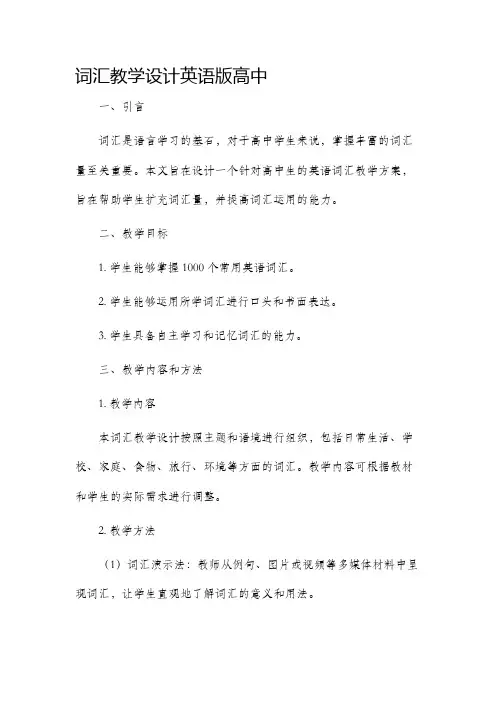
词汇教学设计英语版高中一、引言词汇是语言学习的基石,对于高中学生来说,掌握丰富的词汇量至关重要。
本文旨在设计一个针对高中生的英语词汇教学方案,旨在帮助学生扩充词汇量,并提高词汇运用的能力。
二、教学目标1. 学生能够掌握1000个常用英语词汇。
2. 学生能够运用所学词汇进行口头和书面表达。
3. 学生具备自主学习和记忆词汇的能力。
三、教学内容和方法1. 教学内容本词汇教学设计按照主题和语境进行组织,包括日常生活、学校、家庭、食物、旅行、环境等方面的词汇。
教学内容可根据教材和学生的实际需求进行调整。
2. 教学方法(1)词汇演示法:教师从例句、图片或视频等多媒体材料中呈现词汇,让学生直观地了解词汇的意义和用法。
(2)词汇联系法:通过词汇游戏、配对练习、填空练习等活动帮助学生巩固所学词汇。
(3)词汇运用法:教师引导学生在真实的交际情境中运用所学词汇,例如进行口语对话、写作等。
四、教学步骤1. 预热(5分钟)教师通过展示以新词汇为主题的图片或例句,引发学生的兴趣,并询问学生对这些词汇的了解程度。
2. 词汇演示(10分钟)教师利用多媒体工具展示词汇的示意图、例句或视频,让学生理解词汇的意义和用法。
3. 词汇练习(20分钟)教师设计配对练习、填空练习或词汇游戏,让学生进行词汇巩固练习。
教师可以根据学生的水平和需要进行分组,提供不同难度的练习。
4. 词汇运用(15分钟)教师组织学生进行口语对话或写作练习,鼓励学生在真实的语境中运用所学词汇。
通过教师的点评和反馈,帮助学生提高词汇运用的准确性和流利度。
5. 课堂总结(5分钟)教师对本节课的学习内容进行总结,并给予肯定和鼓励。
同时,教师可以提醒学生继续多做词汇练习,坚持运用所学词汇。
五、教学评估1. 学生课后完成词汇练习题,教师进行批改并给予反馈。
2. 学生进行对话或写作练习,教师进行评分并提供建议。
3. 学生参与词汇游戏或其他合作活动,教师进行观察并评估学生的表现。

基于话题的高三英语一轮词汇复习—— heroes in harm's way教学案例引言:王蔷教授也曾强调“语言源于生活,语言学习不应该紧紧围绕词汇和语法知识来学习,语言的理解和表达都与生活紧密相连……而学习解决问题的过程必须通过参与真实生活情境的活动来加以解决”(王蔷,2016)。
因此教师在选择材料时,“可选择与单元话题相关且包含高考核心词汇较多的新闻素材才,实现课堂与生活的有效衔接”(黄娟,2020)i.理论依据英语学科所含的三大主题语境又分别涵盖十大主题群以及所对应的32个语境范围。
其中的人与社会以其内容丰富性,有“社会服务与人际沟通”“文学、体育与艺术”“历史、社会与文化”“科学与技术”四个主题群和下设的16项子主题。
本课以人与社会主题语境和“历史、社会与文化”主题群为切入点,选择了16项子主题里面对社会有突出贡献的人物和社会热点问题两项话题作为理论依据,以武汉爆发疫情之时,涌现了无数传递正能量的逆行者为具体情境筛选和原创了英文阅读材料,设计了本节一轮复习词汇课heroes in harm’s way (逆行者)。
ii.教学内容分析本课的八个目标词块分别:①work selflessly in ②fight against③be grateful to ④devote oneself to⑤a specialist in⑥an outbreak of⑦die of⑧get infected其中devote oneself to,work selflessly in,fight against和be grateful to 选自必修一五单元nelson mandela- a modern hero,所选短语涉及曼德拉和白求恩;其中a specialist in和 devote oneself to 选自必修四一单元great women and their achievements,所选短语涉及到林巧稚;其中an outbreak of和die of 选自必修五的一单元great scientist,所选短语分别涉及到阅读文章霍乱这种传染病;最后一个短语get infected,选自必修五第五单元,描述皮肤烧伤急救的措施。
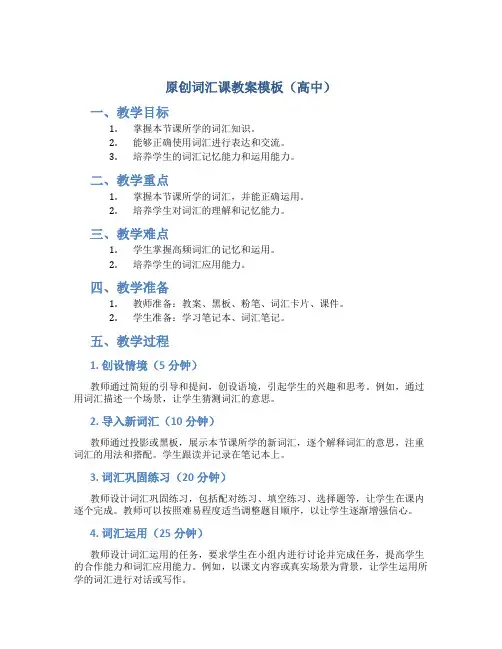
原创词汇课教案模板(高中)一、教学目标1.掌握本节课所学的词汇知识。
2.能够正确使用词汇进行表达和交流。
3.培养学生的词汇记忆能力和运用能力。
二、教学重点1.掌握本节课所学的词汇,并能正确运用。
2.培养学生对词汇的理解和记忆能力。
三、教学难点1.学生掌握高频词汇的记忆和运用。
2.培养学生的词汇应用能力。
四、教学准备1.教师准备:教案、黑板、粉笔、词汇卡片、课件。
2.学生准备:学习笔记本、词汇笔记。
五、教学过程1. 创设情境(5分钟)教师通过简短的引导和提问,创设语境,引起学生的兴趣和思考。
例如,通过用词汇描述一个场景,让学生猜测词汇的意思。
2. 导入新词汇(10分钟)教师通过投影或黑板,展示本节课所学的新词汇,逐个解释词汇的意思,注重词汇的用法和搭配。
学生跟读并记录在笔记本上。
3. 词汇巩固练习(20分钟)教师设计词汇巩固练习,包括配对练习、填空练习、选择题等,让学生在课内逐个完成。
教师可以按照难易程度适当调整题目顺序,以让学生逐渐增强信心。
4. 词汇运用(25分钟)教师设计词汇运用的任务,要求学生在小组内进行讨论并完成任务,提高学生的合作能力和词汇应用能力。
例如,以课文内容或真实场景为背景,让学生运用所学的词汇进行对话或写作。
5. 总结归纳(10分钟)教师引导学生回顾本节课所学的词汇,并总结归纳词汇的用法和搭配。
教师可以提供一些补充的例句和相关知识点,帮助学生更好地理解和记忆词汇。
6. 课堂小结(5分钟)教师对本节课的内容进行小结,并鼓励学生在日常学习中多加复习和应用所学的词汇知识。
六、学生作业布置课后作业,要求学生复习本节课所学的词汇,并运用到实际生活中。
可以要求学生写一篇关于词汇应用的短文,或设计一组有关词汇的问答题目。
七、板书设计黑板上可以简洁明了地写下本节课所学的词汇和相关例句,以及一些重点知识点。
八、教学反思本节课设计了多种形式的词汇练习和运用任务,能够激发学生的学习兴趣,增强学生的词汇运用能力。
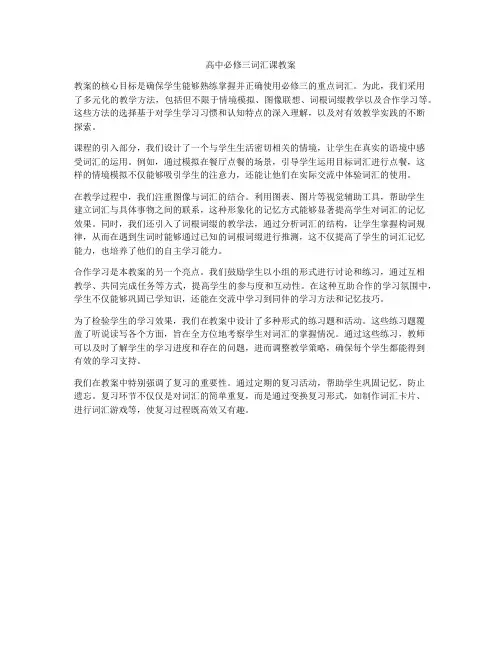
高中必修三词汇课教案教案的核心目标是确保学生能够熟练掌握并正确使用必修三的重点词汇。
为此,我们采用了多元化的教学方法,包括但不限于情境模拟、图像联想、词根词缀教学以及合作学习等。
这些方法的选择基于对学生学习习惯和认知特点的深入理解,以及对有效教学实践的不断探索。
课程的引入部分,我们设计了一个与学生生活密切相关的情境,让学生在真实的语境中感受词汇的运用。
例如,通过模拟在餐厅点餐的场景,引导学生运用目标词汇进行点餐,这样的情境模拟不仅能够吸引学生的注意力,还能让他们在实际交流中体验词汇的使用。
在教学过程中,我们注重图像与词汇的结合。
利用图表、图片等视觉辅助工具,帮助学生建立词汇与具体事物之间的联系,这种形象化的记忆方式能够显著提高学生对词汇的记忆效果。
同时,我们还引入了词根词缀的教学法,通过分析词汇的结构,让学生掌握构词规律,从而在遇到生词时能够通过已知的词根词缀进行推测,这不仅提高了学生的词汇记忆能力,也培养了他们的自主学习能力。
合作学习是本教案的另一个亮点。
我们鼓励学生以小组的形式进行讨论和练习,通过互相教学、共同完成任务等方式,提高学生的参与度和互动性。
在这种互助合作的学习氛围中,学生不仅能够巩固已学知识,还能在交流中学习到同伴的学习方法和记忆技巧。
为了检验学生的学习效果,我们在教案中设计了多种形式的练习题和活动。
这些练习题覆盖了听说读写各个方面,旨在全方位地考察学生对词汇的掌握情况。
通过这些练习,教师可以及时了解学生的学习进度和存在的问题,进而调整教学策略,确保每个学生都能得到有效的学习支持。
我们在教案中特别强调了复习的重要性。
通过定期的复习活动,帮助学生巩固记忆,防止遗忘。
复习环节不仅仅是对词汇的简单重复,而是通过变换复习形式,如制作词汇卡片、进行词汇游戏等,使复习过程既高效又有趣。

高中英语词汇课教学设计一、教学任务及对象1、教学任务本节课的教学任务是以高中英语词汇为核心,通过多样化教学策略,帮助学生掌握并运用英语词汇。
具体包括:引入新词汇,解析词汇含义,通过例句和语境展示词汇用法,指导学生进行词汇练习,提高学生的词汇记忆力和应用能力。
2、教学对象本节课的教学对象为高中学生,他们已经具备一定的英语基础,掌握了一些基本的词汇和语法知识。
但在词汇学习方面,仍存在一定的困难,如词汇记忆不牢、应用不灵活等。
因此,本节课将针对这些问题,采取有效的教学策略,帮助学生提高词汇学习效果。
同时,考虑到学生的个体差异,教学中将注重因材施教,激发学生的学习兴趣和积极性。
二、教学目标1、知识与技能(1)掌握本节课所教授的高中英语词汇,包括单词的拼写、发音、词性和基本含义。
(2)学会运用词汇进行造句,并能将这些词汇运用到实际语境中,提高英语表达能力。
(3)通过词汇学习,拓展学生的词汇量,为今后的英语阅读、写作和口语交流奠定基础。
(4)培养学生查阅词典、自主学习的习惯,提高学生解决问题的能力。
2、过程与方法(1)采用多元化的教学方法,如情境教学法、任务型教学法、合作学习法等,激发学生的学习兴趣,提高课堂参与度。
(2)引导学生通过观察、思考、实践等途径,发现词汇学习的规律,培养学生的自主学习能力。
(3)组织丰富的课堂活动,如词汇接龙、角色扮演、小组讨论等,让学生在实践中掌握词汇,提高应用能力。
(4)注重课堂反馈,及时发现并解决学生在词汇学习过程中遇到的问题,提高教学效果。
3、情感,态度与价值观(1)培养学生对英语词汇学习的兴趣,激发学生学习英语的内在动力,形成积极的学习态度。
(2)引导学生认识到词汇学习的重要性,使其明白词汇是英语学习的基础,提高学生对词汇学习的重视程度。
(3)通过课堂互动,培养学生的团队协作精神,学会与人沟通、交流,增强集体荣誉感。
(4)培养学生具有跨文化意识,了解中外文化差异,尊重不同文化背景,提高学生的综合素质。
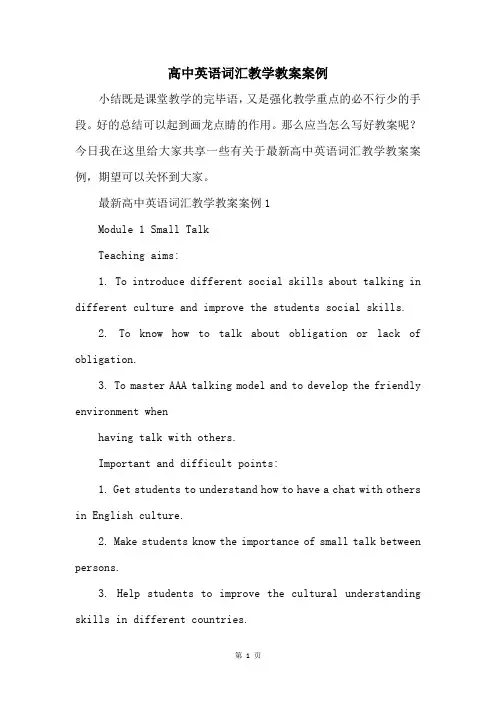
高中英语词汇教学教案案例小结既是课堂教学的完毕语,又是强化教学重点的必不行少的手段。
好的总结可以起到画龙点睛的作用。
那么应当怎么写好教案呢?今日我在这里给大家共享一些有关于最新高中英语词汇教学教案案例,期望可以关怀到大家。
最新高中英语词汇教学教案案例1Module 1 Small TalkTeaching aims:1. To introduce different social skills about talking in different culture and improve the students social skills.2. To know how to talk about obligation or lack of obligation.3. To master AAA talking model and to develop the friendly environment whenhaving talk with others.Important and difficult points:1. Get students to understand how to have a chat with others in English culture.2. Make students know the importance of small talk between persons.3. Help students to improve the cultural understanding skills in different countries.Teaching procedures:Period One Introduction and FunctionStep 1. In this part, the teacher can talk with studentsin small talk, and the teacher can choose different topic with different students.For example:T: What do you think of yesterdays football match between your class and Class 3?S1: Its great.S2: We won.T: Do you know why you won?S3: We are strong.T: Good. When we were discussing the football match just now, we were discussing serious things or having light conversation?Ss: Light conversation.T: Oh, yes. Just small talk.Step 2. After the teacher tell the students small talk, the students begin to read the dictionary definitions of small talk then ask the students to discuss the four questions inActivity1. Step 3. Divide the students into groups of two ones to discuss the five questions in Activity2. Then the teacher canchoose some groups of students to show their small talk to all the students. The Ss can have different opinions, but they must give the reason for their opinions.Step 4. Make a talk between the Ss and the teacher, then introduce the topic about must, have to, dont have to and mustnt. For example:T: You are now in Senior Two, and I think you are all good students, although some of you sometimes behave not very properly. So Im going to ask you some questions. Do you think students have to be on time at school?Ss: ...T: Oh, yes. You are right. You have to. Then say something that you must do.S1: ...S2: ...T: And anything you mustnt do?S1: ...S2:...Ask the Ss to talk about the following topics:What is obligation?What is lack of obligation?According to the talking method, the teacher can introducethe definitions of obligation and lack of obligation.Step 5. Ask the students to finish Activity1 and then let the Ss to talk about the answers they have made.Ask the Ss to make similar sentences impressing obligation and lack of obligation using the words they just practiced. Step 6. Make a competition among the Ss to make sentences using must, have to, dont have to, mustnt, neednt do and dont need do. And the team which make sentences will win the competition.Period Two Vocabulary and ReadingStep 1. Ask Ss to discuss the sentences in Activity 1 and then check the answers of the Ss. Then learn the words in this part with the Ss.Step 2. Ask the Ss to read the text quickly and then finish Activity2. Then ask all the Ss to discuss the questions of Activity 4. Then ask the Ss to tell us the usage of the words in Activity1 and Activity 4 and find the sentences in the text: impress, damage, encourage, prepare, avoid, lack, recognize, smile.Step 3. Ask the students to read the text again, then answer the questions in Activity3 and encourage the Ss to have different answers. If the time isnt enough, we can solve theproblem in the following ways.(1) Discuss it after class.(2) Discuss the following questions as the important points.I. What do people think about those who talk too much?II. Why is it a good idea to nod and smile when the other person is talking?III. What does the quotation from Benjamin Disraeli tell you about people?Then ask the Ss to prepare for Activity5 and then ask the Ss to tell the meanings of the phrases.Step 4. Important word or phrases1. Which definitions make small talk sound like a positive thing?Sound is a link verb, its meaning in Chinese:听起来。

高中英语词汇讲解教案【篇一:高中英语教学案例分析词汇】高中英语教学案例分析vocabulary –learning in smartways二.课型:学习方法探究课二. 教材分析:1. 教学内容:sefc book 6必修阶段性词汇学习方法探究(见文末)2. 教材处理:这是一堂笔者根据新的课程标准,结合本人对词汇教学方法的实践积累和思考进行设计的一堂探究课。
该课创造性地选择了授课内容,对使用性较强的词汇方法进行了整理与补充,改变注重传授知识的倾向,采用“任务型”教学模式,进行了一次实验和探究。
该课的中心话题是“三鹿毒奶事件”,内容引发学生对食品安全的关注和思考。
该课旨在启发学生去思考自我梳理知识和自主学习的模式,让学习过程有一个延续的趋势。
同时,提供一次实际运用英语表达交流思想的机会,增强使用英语的信心。
三、学情分析:笔者首先考虑为什么和怎么上这节课,使教学目标的设计实在可行。
笔者的授课对象是属于三流水平的一个互助结对县中学,这个班为普通平行班,英语基础较差,但是大部分学生的思维活动、学习热情、表现欲望和合作精神是可以在平时的教学中不断提高和培养的。
怎样使得一节课对学生今后的学习有所思考和帮助,也是笔者要考虑的问题。
综上因素,根据学情,笔者采用活动式的教学方法上一堂关于词汇学习的课,期待对今后的学习中新旧知识的连接有所帮助;同时注意运用鲜活真实的语言材料吸引学生,提高学生答题的兴趣,同时便于设题。
兼顾设计内容简单化,便于调动全班学生的积极性,在互动中实现教学任务和目标。
四、教学目标1、学习并改善词汇学习的效果;2、能根据词汇的构成特点,归纳整理学习和记忆的方法;3、增强社会责任感,关注和谐社会的发展。
五、设计理念:高中英语新课程标准加强了对词汇的要求,高中阶段从原来的1800~2000个增加到3300个单词和400~500个习惯用语或固定搭配,词汇量掌握的多少在一定程度上制约着学生运用语言能力的高低。
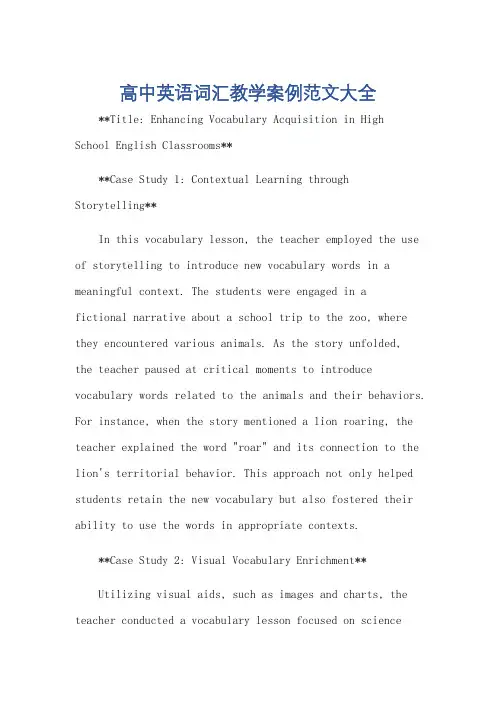
高中英语词汇教学案例范文大全**Title: Enhancing Vocabulary Acquisition in HighSchool English Classrooms****Case Study 1: Contextual Learning throughStorytelling**In this vocabulary lesson, the teacher employed the use of storytelling to introduce new vocabulary words in a meaningful context. The students were engaged in afictional narrative about a school trip to the zoo, where they encountered various animals. As the story unfolded,the teacher paused at critical moments to introduce vocabulary words related to the animals and their behaviors. For instance, when the story mentioned a lion roaring, the teacher explained the word "roar" and its connection to the lion's territorial behavior. This approach not only helped students retain the new vocabulary but also fostered their ability to use the words in appropriate contexts.**Case Study 2: Visual Vocabulary Enrichment**Utilizing visual aids, such as images and charts, the teacher conducted a vocabulary lesson focused on scienceterminology. Students were shown diagrams of cells, atoms, and other scientific concepts. As they observed the visuals, the teacher introduced the corresponding vocabulary words, explaining their significance and usage in scientific contexts. This hands-on approach allowed students toconnect the abstract vocabulary with visual representations, enhancing their understanding and retention.**Case Study 3: Collaborative Vocabulary Building**In this lesson, students were divided into small groups and assigned a topic each. They were challenged to create a vocabulary list related to their topic, includingdefinitions and sentence examples. Groups then presented their lists to the class, explaining the significance of each word and how it could be used in real-life situations. This collaborative activity fostered peer learning and encouraged students to think critically about word choice and context.**Case Study 4: Vocabulary Games and Quizzes**To make vocabulary learning more engaging, the teacher introduced vocabulary games and quizzes into the classroom. Students participated in jeopardy-style games, where theyhad to answer questions related to the new vocabulary words. The quizzes were designed to test their understanding of word meanings, synonyms, and antonyms. This competitive element not only kept students engaged but also helped them consolidate their vocabulary knowledge.**Case Study 5: Incorporating Technology in Vocabulary Instruction**Leveraging technological tools, the teacher utilized online vocabulary resources and interactive platforms to enhance vocabulary learning. Students were introduced to online dictionaries and vocabulary-building apps that allowed them to explore word meanings, pronunciations, and usage examples. The teacher also used interactive whiteboards to conduct vocabulary games and quizzes, making the learning process more dynamic and engaging.**Conclusion**These vocabulary teaching strategies demonstrate the diversity and effectiveness of approaches that can be employed in high school English classrooms. Byincorporating contextual learning, visual aids,collaborative activities, games, quizzes, and technology,teachers can create an engaging and comprehensive vocabulary learning environment that fosters student engagement and improves word retention.**高中英语词汇教学案例范文大全****案例研究1:通过故事叙述的语境学习**在这堂词汇课中,教师运用讲故事的方式,在有意义的故事背景中引入新的词汇。
原创词汇课教案模板高中一、教学目标本节课的教学目标主要包括:1.学习并掌握一定量的高中英语词汇;2.提高学生的词汇记忆和运用能力;3.培养学生的词汇拓展意识和实际运用能力。
二、教学内容本节课的教学内容为高中英语词汇。
三、教学重点和难点1. 教学重点•学习和记忆高中英语必备词汇;•培养学生灵活运用词汇的能力。
2. 教学难点•如何让学生记忆高效地掌握大量词汇;•如何让学生能够在实际运用中灵活运用所学词汇。
四、教学准备•教师准备好词汇教材和相关教学资料;•教师准备好多媒体设备以支持教学。
五、教学过程1. 导入(5分钟)通过提问或展示图片等方式引起学生对词汇的兴趣,并导入本节课的主题。
2. 学习词汇(25分钟)利用多媒体设备,以短语、例句、图片等形式呈现词汇,帮助学生理解和记忆词汇的意思和用法。
3. 拓展运用(20分钟)让学生通过各种形式的练习,如填空、造句、讨论等,进行词汇的拓展运用,以提高学生的词汇应用能力。
4. 小结与评价(5分钟)教师对本节课所学内容进行小结,并对学生的学习表现进行评价和指导。
六、教学延伸教师可以要求学生通过阅读、写作等方式进一步巩固所学词汇,并在下节课进行相关的检测和复习。
七、教学反思本节课的教学内容主要是围绕词汇的学习展开,通过多种教学手段让学生掌握并记忆所学词汇。
同时通过拓展运用的环节,培养学生的灵活运用词汇的能力。
整个教学过程设计紧凑,内容丰富,可以有效地提高学生的词汇水平和运用能力。
然而,需要注意的是在教学过程中要根据学生的实际情况和学习能力合理安排教学进度,确保教学进程和学习效果的平衡。
同时,还要注重培养学生的词汇拓展意识,引导他们自主学习和积累更多的词汇知识。
总之,通过有效的教学设计和灵活的教学方法,可以提高学生的词汇水平,使他们能够更好地应对英语学习和实际应用中的词汇问题。
高中英语教学案例描述
案例描述:
本案例是关于高中英语教学的,主要涉及到词汇教学和阅读理解教学。
一、词汇教学
在一次高一英语课上,教师正在教授一个新单元的词汇。
教师首先通过图片和实物引导学生猜测新词的意思,然后展示单词卡片,让学生读出单词并尝试解释其含义。
接着,教师设计了一些活动,如单词接龙、填空游戏等,让学生在游戏中记忆和巩固新词。
最后,教师布置了一些课后作业,要求学生用新词造句,并在下节课上进行分享。
二、阅读理解教学
在一次高二英语课上,教师正在教授一篇关于环保的阅读理解文章。
教师首先带领学生阅读全文,然后提出一些问题,让学生思考文章的主题和主要内容。
接着,教师让学生分组讨论文章中的细节问题,如作者的观点、文章的结构等。
然后,教师让学生自己阅读文章,并完成一些阅读理解题目。
最后,教师让学生分享他们的解题思路和方法,并对全班的答案进行讲解和讨论。
通过这两个案例,我们可以看到,高中英语教学需要注重学生的参与和实践,通过各种活动和任务,帮助学生掌握和运用英语知识。
同时,教师也需要关注学生的学习过程和结果,及时给予反馈和指导,以提高教学效果。
高中词汇课教案模板一、教学目标明确教学目标是制定教案的第一步。
在这个环节中,教师需要设定具体、可量化的目标,比如学生能够掌握30个与日常生活紧密相关的新词汇,并能在句子中正确使用它们。
同时,学生应能够在听力练习中识别出这些词汇,并能够在口语交流中流畅地运用。
二、课前准备课前准备工作包括教学材料的搜集和整理,如单词卡片、图片、例句等。
教师应该设计一些预习任务,让学生对即将学习的词汇有一个初步的了解和认识。
例如,可以要求学生浏览一篇短文,标记出不熟悉的单词,或者通过网络资源查找单词的意义和用法。
三、课堂导入课堂导入是激发学生兴趣的关键阶段。
教师可以通过提问、小故事、有趣的图片或视频来引入新词汇。
例如,如果本节课的主题是“饮食”,教师可以展示几张不同国家食物的图片,引导学生用英语描述他们看到的食物,从而自然地过渡到新词汇的学习。
四、词汇讲解在这一部分,教师需要详细讲解每个新词汇的意义、发音、词性和用法。
可以通过情景对话、同义词/反义词对比、词汇搭配等方式来加深学生对单词的理解。
为了确保学生能够跟上进度,教师应该控制讲解的速度,并在适当的时候进行复习。
五、互动练习通过各种互动活动来巩固新学的词汇。
这些活动可以是小组讨论、角色扮演、快速问答游戏等。
例如,教师可以设计一个“词汇接龙”游戏,每个学生必须用上一个学生的单词的最后一个字母开始他/她的单词,这样可以在轻松愉快的氛围中加强记忆。
六、巩固拓展为了让学生更深入地理解和运用新词汇,教师可以布置一些写作或项目作业。
比如,让学生写一篇短文,使用至少10个新学的词汇,或者制作一个关于这些词汇的海报或T。
这样的作业不仅能够检验学生的学习成果,还能够提高他们的创造力和批判性思维能力。
七、课后总结每堂课结束后,教师应该总结本次课程的重点内容,并对学生的表现进行简单的评价。
同时,教师可以提供一些额外的学习资源,如在线词汇练习、推荐书目或电影等,帮助学生在课外继续学习和探索。
一、教学目标1. 知识目标:使学生掌握本节课的词汇,包括单词的音、形、义、用,并能正确运用。
2. 能力目标:培养学生从语境中猜测词意的能力,提高学生的词汇运用能力。
3. 情感目标:激发学生学习英语的兴趣,培养学生热爱英语的情感。
二、教学内容1. 课文:选取一篇与生活贴近的课文,如:《A Trip On The True North》。
2. 词汇:课文中的重点词汇,如:continent, baggage, chat, scenery, eastward, westward, upward, surround, the Rocky Mountains, harbour, measure, aboard, settle down, manage to do, catch sight of, eagle, Stampede, cowboy, have a gift for, within, border, slight, slightly, acre, urban, Thunder Bay, Lake Superior。
三、教学过程1. 导入(1)复习上节课所学内容,巩固旧知识。
(2)播放与课文相关的图片或视频,激发学生的学习兴趣。
2. 课文朗读(1)学生跟读课文,注意语音、语调。
(2)教师引导学生分析课文中的重点词汇,讲解词义、用法。
3. 词汇学习(1)教师利用PPT展示词汇卡片,引导学生认读、拼写。
(2)学生分组,进行词汇接龙游戏,巩固所学词汇。
4. 语境猜测(1)教师设置情景,让学生根据上下文猜测词意。
(2)学生展示猜测结果,教师点评并纠正。
5. 构词法学习(1)教师讲解构词法的基本知识,如:前缀、后缀、词根等。
(2)学生练习构词法,尝试根据所学词汇进行词义推断。
6. 词汇运用(1)教师设计填空、翻译等练习,让学生运用所学词汇。
(2)学生展示练习成果,教师点评并纠正。
7. 总结(1)教师对本节课所学内容进行总结,强调重点词汇。
高中词汇教学案例分析词汇教学在高中英语教学中占据重要地位,对学生的语言能力提升起着至关重要的作用。
本文将通过一个实际的教学案例来分析高中词汇教学的方法和策略,以期能够为教师在实际教学中提供一些参考和帮助。
案例背景:这个教学案例发生在某个高中英语课堂上,教师的教学目标是帮助学生扩展词汇量,提升他们的阅读理解能力。
教师选择了一篇有关环境保护的短文作为教材,该短文涉及了大量的专业词汇和短语。
学生的英语水平相对较低,对于这些词汇和短语的理解和应用存在困难。
教学过程:教师在开始教学之前,通过设计一系列的预热活动来调动学生的学习积极性。
例如,教师播放一段关于环境保护的短视频,并组织学生进行讨论,以激发学生对环境问题的兴趣并提前接触相关的词汇。
接着,教师开始正式的教学环节。
1. 词汇预习教师要求学生在课前完成一些词汇预习任务,例如查阅词典,了解并记录下与环境保护相关的词汇和短语。
在课堂上,教师要求学生将自己预习的结果进行展示和分享,这样有利于激发学生的学习兴趣,并且可以让学生相互学习和借鉴。
2. 词汇解释与归纳教师通过解释和举例的方式,为学生介绍和解释了一些专业词汇和短语的含义。
为了避免学生的被动接受,教师采用了互动的方式,不断与学生互动交流,确保学生对于词汇的理解和掌握。
3. 词汇练习为了让学生巩固所学的词汇,教师设计了一系列的词汇练习活动,例如填空、配对、造句等。
这些活动旨在激发学生的学习兴趣,让学生在实践中掌握和运用词汇。
教学效果:通过对这个案例的分析,我们可以看到这样一个事实,即通过设计恰当的教学任务和活动,结合互动和合作学习,能够提高学生对于词汇的记忆和应用能力。
在这个案例中,学生在完成课堂活动的过程中,不仅仅掌握了大量的环境保护相关的词汇和短语,同时也提升了阅读理解的能力。
结论:词汇教学是高中英语教学中的重要一环,通过设计富有趣味和实践性的教学活动,能够提高学生对于词汇的掌握程度和运用能力。
同时,互动和合作学习也是促进学生积极参与和学习的重要策略。
课时:2课时年级:高中教材:《人教版高中英语教材》教学目标:1. 学生能够熟练掌握本节课的10个核心词汇。
2. 学生能够运用所学词汇进行简单的句子表达。
3. 培养学生自主学习和合作学习的能力。
教学重点:1. 词汇的拼写和读音。
2. 词汇的用法和搭配。
教学难点:1. 词汇的记忆和理解。
2. 词汇在实际语境中的应用。
教学过程:第一课时:一、导入1. 利用图片、视频等素材,激发学生学习兴趣。
2. 提问:同学们,你们知道这些词汇的意思吗?它们在生活中有哪些应用呢?二、新课导入1. 教师带领学生朗读课文,让学生初步了解本节课的10个核心词汇。
2. 教师用PPT展示每个词汇的拼写、读音和例句,引导学生进行跟读和模仿。
三、词汇讲解1. 教师讲解每个词汇的基本意思、用法和搭配。
2. 学生根据教师讲解的内容,总结每个词汇的特点。
四、词汇练习1. 教师设计词汇填空、选择、翻译等练习题,让学生巩固所学词汇。
2. 学生独立完成练习,教师巡视指导。
五、小组合作1. 将学生分成若干小组,每组选择一个词汇进行深入研究。
2. 各小组汇报研究成果,教师点评并总结。
六、课堂小结1. 教师对本节课所学词汇进行总结,强调重点和难点。
2. 学生分享学习心得,提出疑问。
第二课时:一、复习导入1. 教师提问:同学们,上一节课我们学习了哪些词汇?它们的意思和用法是什么?2. 学生回答问题,教师点评。
二、词汇运用1. 教师设计情景对话,让学生运用所学词汇进行表达。
2. 学生分组进行角色扮演,教师巡视指导。
三、拓展练习1. 教师提供一篇短文,让学生找出并运用本节课所学词汇。
2. 学生独立完成练习,教师批改并讲解。
四、课堂小结1. 教师对本节课所学内容进行总结,强调重点和难点。
2. 学生分享学习心得,提出疑问。
五、课后作业1. 复习本节课所学词汇,掌握其拼写、读音、用法和搭配。
2. 预习下一节课的内容。
教学反思:1. 本节课通过多种教学方法,激发了学生的学习兴趣,提高了学生的词汇学习效果。
一节高中英语词汇教学案例
一.词汇教学现状
现行的英语词汇教学现状可以总结如下:
1. 照本宣科型:一是跟读单词,二是讲解教材中出现的词义。
2.词典搬家型:“词典搬家,全面开花”至少有三个弊端:一是消耗时间,二是冲淡主题,三是扰乱认知。
3.过度集中型:3-4周内背记整本书的单词,弊端是单调苦燥,不符合认知规律。
4.敬而远之型:老师懂得处理词汇,但不知如何处理比较合适,即在何时、怎样处理课文中的词汇,一句话,不敢面对词汇。
二.词汇教学目的:
1. 通过词汇教学,有意识地培养学生运用词汇学习策略来识记词汇并能在语境下恰当地运用语言的能力。
2.通过使用不同的呈现方法,加深学生对词汇的记忆,促进学生探索词汇学习的最佳方法。
3.培养自主学习能力
三.词汇教学过程
本课讲的是人教版高中英语Great Inventions 的语言点。
我提前布置了任务,要求学生预习并在字典中查找自己认为最重要的词汇包括短语或惯用语。
一上课开始例行的值日生词汇检查,之后开始上词汇课。
I begin to show some pictures made with Powerpoint in a computer .Then
I asked the students one by one to say what they saw in the pictures. In picture1, the students only saw a sign means “stop’’therefore some of them couldn’t make connection of this one with a phrase “be aware of”.They would say some sentences like this:”when you walk across the street, you must pay attention to traffic lights or here is not allowed to smoke or others. At this time I began to ask the students what the sign said and when we saw this sign , what should be aware of. Following that , all the students said that they would be aware of safety.Then I asked my students to make sentences with the phrase be aware of as much as possible. Picture 2,3,4,5,6,7 are very easy . When they saw them , they would quickly remember what words they were. Once for a while I interestingly asked them what made the size of a computer reduced from desktops to laptops to palmtops and If they pretended to be specialists of a computer whether they allow for their creativity. After that the students discussed for a while ,then one reported the result. Picture8 tends to make the students remind the word “experiment”or ”laboratory”instead of “trial but they knew trial and error could lead to success and the truth of success is trial and error. Picture9 is about a “pilot “and picture10 is “heel”while picture11 ,12 and 13 need hard guess. Because in these pictures they couldn’t see “petrol ““connection”and “background”, teacher must lead in. For example I asked my students the following questions : What does picture 11 describe? Is it a gas station? What does the driver do ? What do Americans say “汽油”?When you see picture 12, what do you feel ? what association do you make? ( we often connect this China knot with good luck ) and in picture13, can you see the black color? What function is it used as? In this way, the students had a quick overview of some important new words in Unit 18. Secondly, I quickly show these pictures to the students. Then let them repeat these new words. In class I found it interesting for students to learn new words and with this method students’motivation can be aroused. What’s more ,it’s easy for them to remember new words. When I finished this task , I began to check the students’preparations.
In latter half class, the students play leading roles in class. They voluntarily come to the blackboard to teach the others the key words and phrases that they think are very important in this unit . Although it is impossible for them to find the key points accurately , in practice they know how to learn new vocabulary. What ‘s more, the students are very active in involving in class.
四.课后反思
反思1:学生学习的主动积极性是学生学习的动力源泉而学习需要是学生长期坚持的内驱力。
学习需要是指个体在活动中感到有某种欠缺而力求获得满足的心理状态。
它的主观体验形式是学习者饿学习愿望和学习意想。
它包括学习的兴趣爱好和学习的信念等。
所以在教学中教师应想方设法创造环境调动学生的主动积极性,挖掘学生的内驱力。
反思2:建构主义者认为,学习是学习者主动建构内部心理表征的过程。
这里,“建构”是学习者通过新旧知识经验之间反复的,双向的相互作用,来形成和调整自己的经验结构的过程。
在这种构件过程中,一方面,学习者对当前信息的理解需要以原有的知识经验为基础;另一方面,对原有知识经验的运用又不是简单的提取和套用,个体同需要依据新经验对原有经验本身也做出某种调整和改造,即同化和顺应两方面的统一。
学习词汇就是学生建构词汇的过程,在词汇教学中教师的首要任务是应将新旧知识建立起某种联系,并通过图表将知识形象化的联系起来,以便于学生长久地贮存。
五.讨论学习
通过本节英语词汇教学案例的学习,小组内成员也很认同此位老师的看法,认为目前我校教师大部分也存在如这位教师所说的词汇教学现状。
他的这节英语词汇教学案例,为我们小组内成员及广大英语教师进行词汇教学的课堂实践提供了很好的范例。
下一步我们教师在词汇教学的多样性和培养学生运用词汇学习策略来识记词汇并能在语境下恰当地运用语言的能力方面应作为词汇教学的突破口。